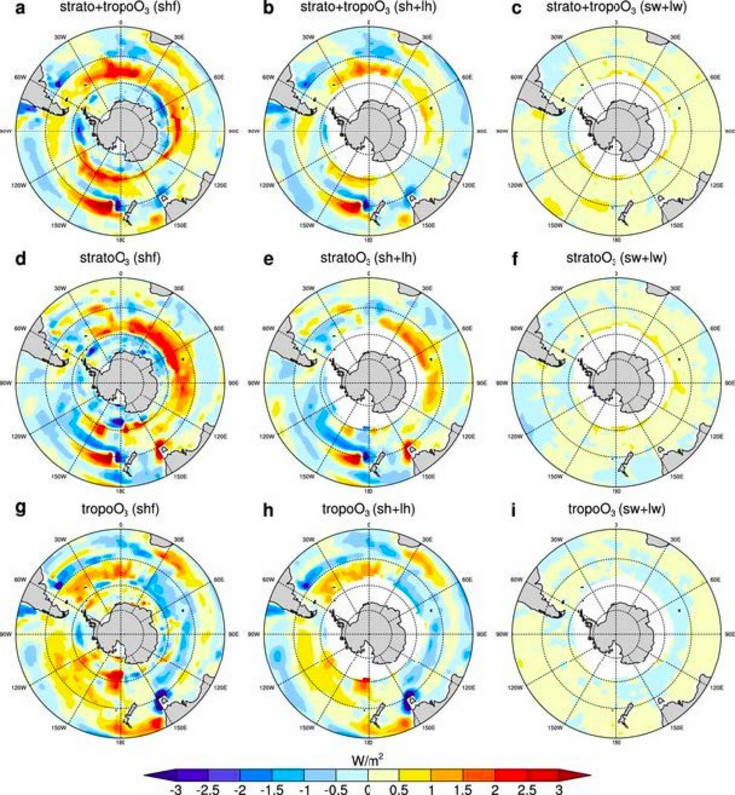04.04.2022 - Changing ozone distribution influences climate change more strongly than previously assumed

Maps of surface heat flux changes over the Southern Ocean in the CanESM5 ozone experiments. © Springer Nature
Ozone is one of the strongest greenhouse gases after carbon dioxide and methane. Since 1955, its concentration in the atmosphere has changed significantly. A new study with participation of BOKU now shows that this is also responsible for about one third of the changed heat absorption capacity in the Southern Ocean and thus weakens one of the most important cooling mechanisms of the Earth much more than previously thought.
Ozone both harms and helps us. Near the ground and in the weather layer, the troposphere, it is an air pollutant, acting as a greenhouse gas and accelerating global warming. In the stratosphere above, it absorbs ultraviolet radiation, protecting us. Since 1955, ozone levels in both layers have changed significantly - and adversely: there was an increase in the troposphere, while concentrations in the stratosphere decreased. Many studies have been made of the change in ozone levels in the atmosphere in terms of its impact on human health. Its contribution to global warming, on the other hand, has received little attention.
"Until now, it was unclear how these changes affect ocean heat uptake," explains Ramiro Checa-Garcia of the Institute of Meteorology and Climatology at BOKU. "In our study, we show that both changes contributed to the warming of the southern ocean, with those near the bottom having a greater impact." The climate model simulations make it clear that about thirty percent of the change in heat uptake by the southern ocean can be explained by changing ozone levels. Here, increases in the troposphere have a greater impact, accounting for sixty percent of the effect - much more than previously thought - while depletion in the stratosphere is attributed forty percent.
Ground-level ozone is formed by so-called precursor gases such as nitrogen oxides and carbon monoxide, which are released during combustion processes in engines, for example. Until now, it was mainly considered a pollutant for humans and the environment. The current study now underscores that ground-level ozone also contributes significantly to climate change, both directly as a greenhouse gas and indirectly because it impairs the ability of the Southern Ocean to absorb excess heat from the atmosphere, Checa-Garcia said. This inhibits one of the most important cooling mechanisms in the wake of global warming. Until now, the increase in ground-level ozone has been considered a factor affecting climate mainly in the northern hemisphere, where the largest emissions of precursor substances occur. Now it is becoming clear that the effect extends to the Antarctic. The changed ozone levels influence the westerly winds of the southern hemisphere, the water temperature, and the salinity of the Southern Ocean. Both affect ocean currents and thus the ocean's heat uptake.
The Montreal Protocol, an international agreement to ban emissions of chlorofluorocarbons (CFCs), which damage the protective ozone layer in the stratosphere, has reduced CFC use by more than 95 percent since 1987. Model projections show that, as a consequence, the stratospheric ozone layer will slowly recover over the next few decades. This makes it clear that international action, if implemented decisively, can mitigate damage to the planet. The research team led by Wei Liu of the University of California Riverside, of which BOKU researcher Ramiro Checa-Garcia is a member, now points out that ground-level ozone is also a global problem and that measures to reduce ground-level ozone concentrations lead to positive effects for human health and the climate.
The study is currently published in the journal Nature Climate Change:
nature.com/articles/s41558-022-01320-w
Contact
Dr. Ramiro Checa-Garcia
University of Natural Resources and Life Sciences, Vienna
Institute for Meteorology and Climatology
E-mail: ramiro.checa-garcia(at)boku.ac.at
Tel.: +43 1 47654 81425
